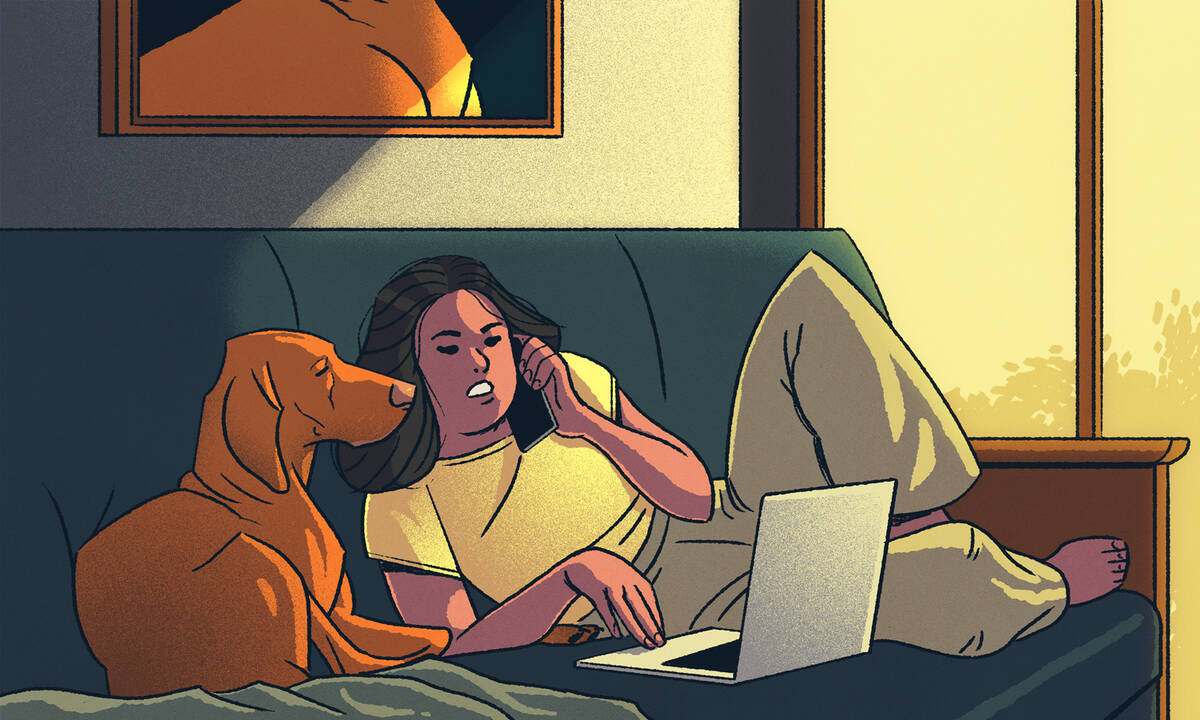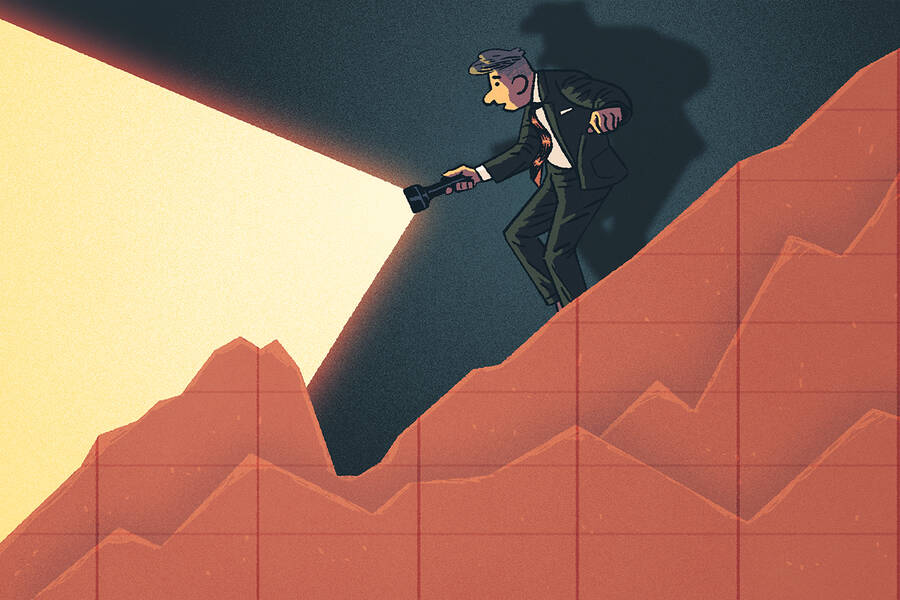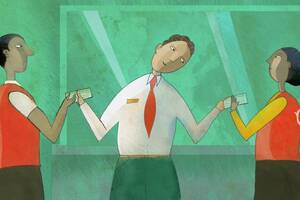Economics Feb 1, 2022
Covid Hit in an Era of Broadband and Zoom. How Much Did That Help the Economy?
A new study sheds light on the impact of remote work on GDP in 2020.

Michael Meier
In September 2020, Janice Eberly gave a keynote talk to a finance society in the UK. Normally, she would have flown overseas and spoken in person to a room of attendees. But in the midst of the COVID-19 pandemic, she addressed people by videoconference from her house in Illinois.
After the talk, Eberly, a professor of finance at Kellogg, chatted with two colleagues and posed a question: What would be different if the COVID-19 pandemic had happened in the early 2000s, when most people didn’t have broadband Internet connections at home and Zoom didn’t exist?
Without a doubt, the virus had been catastrophic for public health and the economy. But in the past, firms might have also laid off or furloughed most office workers; now, many people were still doing their jobs remotely.
Just how much of a difference did this make, the researchers wondered. In an analysis of seven countries, the team found that GDP would have fallen much more steeply in early 2020 if people had not been able to work from home.
The economic contribution of remote workers came not only from their labor but also from these workers providing their own capital. For instance, they converted parts of their homes into makeshift offices and covered the cost of utilities such as electricity and Internet connections. And they repurposed computer equipment that had originally been purchased for personal use to perform work tasks.
Whether companies and employees will—or should—continue to push for remote work in the future isn’t clear. The team’s study suggests that work in many industries is highly “substitutable,” meaning employees are generally able to perform the same tasks at home as in the office. And people’s home office setups are already in place, so little effort is required to stay remote.
“I worry about short-run benefits and long-run costs on both sides.”
— Janice Eberly
But working from home comes with downsides too. For one, it pushes employees “further in the direction of having a gig” rather than a strong attachment to an organization, Eberly says. This type of arrangement could ultimately be detrimental to both the firm and the worker.
“I worry about short-run benefits and long-run costs on both sides,” she says.
Building In Resilience
Businesses have made efforts in the past to create backup plans for moments of crisis. For instance, some firms arranged alternate spaces where employees could work if the power went out in their buildings. Or they cross-trained employees so that critical services could be performed by, say, the Chicago office if the New York office went offline.
Managers generally figured that these stopgap measures would be used only briefly. With COVID, “that strategy you anticipated the need to do for a few days ended up being 18 months,” Eberly says. Yet companies were still able to rally, thanks to the webcam-equipped laptops and fast Internet connections that employees already had available in their homes, along with easy-to-use videoconferencing software.
So just how much did employees contribute to the economy by shifting to working from home? To quantify this, Eberly collaborated with the colleagues with whom she had chatted at the conference, Jonathan Haskel at Imperial College Business School and Paul Mizen at the University of Nottingham. The team focused on seven countries: the United States, UK, Spain, France, Italy, Germany, and Japan.
The researchers gathered data on the countries’ GDP, number of employed people, and the hours they worked. They also compiled information about workplace capital, based on the amount of money firms had spent on expenses such as equipment, office furniture, and property. Records of commercial electricity usage allowed the team to estimate how much offices, factories, and other work spaces were being used. And by using mobility data from Google, the team could also estimate the number of hours employees worked remotely or in person.
A False Productivity Boom
First, the researchers examined declines in output produced at companies’ premises such as offices and factories. They calculated each country’s expected drop in GDP based on those figures—which showed what would have happened without a transition to remote work—and compared them with actual GDP trends.
On average, GDP would have fallen by nearly twice as much from the first to the second quarter of 2020 if no one had been able to work from home, the team estimates. The contribution of remote work was “huge,” Eberly says.
The team then considered productivity: the efficiency of production after accounting for all inputs and outputs. Anecdotally, “we saw firms saying, ‘Wow, we’re so productive during COVID,’” Eberly says. After all, many companies had drastically scaled back on office space or had far lower utilities usage, so their business costs had decreased. Meanwhile, employees kept producing similar levels of output.
That claim appeared to be true in some countries if the researchers accounted only for inputs at workplaces, such as the cost of office space and utilities. In the U.S. and UK, “it actually looked like there was a boom in productivity,” she says.
But this productivity measure doesn’t account for the fact that work space and utilities were still being used at homes to support the business; they were just paid for by employees. “You’re not counting all of the inputs,” she says. Once the team included inputs at home, the boom largely vanished.
So should companies pay for the capital that workers are contributing, such as their home office space and electricity bills? Workers haven’t raised a big stink about these costs yet, perhaps because they no longer have to pay for commuting expenses. But they may eventually start asking firms to compensate them.
“That could easily become part of the contract,” Eberly says.
From Netflix to PowerPoint
The researchers then focused on employees’ home computing equipment. Many people already had laptops and Internet connections at home that they had bought for personal use and repurposed for work during the pandemic. How valuable was that type of capital to the economy?
They found, overall, that workers’ home computing setups contributed roughly as much to countries’ output as did the information and communications technology (ICT) that firms used at workplaces. This result was calculated using a measure called output elasticity. If companies’ ICT doubled, the country’s output would rise by 5 percent; if home computing equipment doubled, output would increase by 4 to 14 percent.
It’s somewhat surprising that the contribution of home capital would be on par with that of workplaces, Eberly says. “It’s not as if you optimized your home computer setup” for your office job, she says. “You probably chose it to watch Netflix.”
The team couldn’t directly measure whether people were more productive at home or at work. But they did look into a related question: As it started to cost companies more to have employees work in person—perhaps due to safety and social-distancing measures—would they respond by shifting people to do their jobs at home? This would suggest a high degree of “substitutability”—meaning much of an employee’s work could be done either at home or in the office.
To investigate, the researchers analyzed survey data from the UK. Companies in a variety of industries had been asked how the costs of keeping employees on the premises had changed over the course of the pandemic. New expenses might have included buying masks for staff or rearranging work spaces so employees could socially distance.
As expenses increased, companies in some industries—particularly professional services—sent employees home to work in greater numbers. And when costs came down again, people returned to their offices.
“We found that there’s a pretty high degree of substitutability,” Eberly says.
Weaker Ties
Clearly, remote work helped bolster economies during a crisis, despite the challenges of pivoting quickly, family-care demands, and the pandemic itself. So should companies and employees automatically embrace remote work for the indefinite future?
Not necessarily, says Eberly. When people provide not only labor but capital, they’re becoming more similar to gig workers who are responsible for their own “kit,” such as a freelance photographer. Remote work could also weaken connections with colleagues and employees’ attachment to their organization.
From the firm’s perspective, that mentality raises the risk that employees will be more likely to leave their jobs for greener pastures. And for workers, career growth could stagnate; moving up in an organization often relies on developing strong ties with colleagues over many years.
“You lose the connectivity that might help you advance at work,” Eberly says.
Roberta Kwok is a freelance science writer in Kirkland, Washington.
Eberly, Janice C., Jonathan Haskel, and Paul Mizen. 2021. “‘Potential Capital,’ Working from Home, and Economic Resilience.” National Bureau of Economic Research. Working paper No. 29431.



